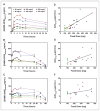Phase I safety, pharmacokinetic, and pharmacodynamic study of ENMD-2076, a novel angiogenic and Aurora kinase inhibitor, in patients with advanced solid tumors
- PMID: 21131552
- PMCID: PMC3867298
- DOI: 10.1158/1078-0432.CCR-10-2144
Phase I safety, pharmacokinetic, and pharmacodynamic study of ENMD-2076, a novel angiogenic and Aurora kinase inhibitor, in patients with advanced solid tumors
Abstract
Purpose: ENMD-2076 is a unique orally bioavailable Aurora kinase and VEGFR inhibitor. The purpose of this phase 1 study of ENMD-2076 was to determine the MTD, pharmacokinetic, and pharmacodynamic profiles and preliminary antitumor activity.
Experimental design: Patients with refractory advanced solid malignancies were treated with ENMD-2076 orally with continuous once daily dosing. Doses from 60 to 200 mg/m(2) were evaluated using a standard 3 (to 4) + 3 design. Pharmacokinetic parameters were studied on days 1, 28, and 30 to 35 of cycle 1. Expanded MTD cohorts included patients with ovarian cancer, colorectal cancer, and refractory solid tumors.
Results: A total of 67 patients (46 F, 21M; ages 30-76) entered the study. Dose levels of 60, 80, 120, 200, and 160 mg/m(2) were evaluated. Two patients experienced grade 3 hypertension at 200 mg/m(2), and additional grade 3 neutropenia events limited tolerability at this dose. An intermediate dose of 160 mg/m(2) was determined to be the MTD. The most common drug-related adverse events included hypertension, nausea/vomiting, and fatigue. The pharmacokinetics of ENMD-2076 were characterized by a rapid absorption phase (T(max) 3-7.8 hours), a t(1/2) of 27.3 to 38.3 hours after a single dose, and dose proportional exposure. Decreased plasma sVEGFR2 was observed posttreatment. Two patients with platinum refractory/resistant ovarian cancer had RECIST partial responses.
Conclusions: ENMD-2076 was well tolerated, had a linear pharmacokinetic profile, and showed promising antitumor activity, particularly in ovarian cancer. The recommended phase 2 dose of ENMD-2076 is 160 mg/m(2) administered orally once daily with continuous dosing.
Trial registration: ClinicalTrials.gov NCT00658671.
©2010 AACR.
Conflict of interest statement
S. G. Eckhardt: consultant, EntreMed, Inc., and stock ownership, EntreMed, Inc.; G. C. Fletcher: employment, EntreMed, Inc.; J. Arnott: employment, EntreMed, Inc.; M. R. Bray: employment, EntreMed, Inc.; C. Sidor: employment, EntreMed, Inc.
Figures



Similar articles
-
A phase I trial of the aurora kinase inhibitor, ENMD-2076, in patients with relapsed or refractory acute myeloid leukemia or chronic myelomonocytic leukemia.Invest New Drugs. 2016 Oct;34(5):614-24. doi: 10.1007/s10637-016-0375-2. Epub 2016 Jul 12. Invest New Drugs. 2016. PMID: 27406088 Clinical Trial.
-
A phase I dose-escalation, safety and pharmacokinetic study of the 2-methoxyestradiol analog ENMD-1198 administered orally to patients with advanced cancer.Invest New Drugs. 2011 Apr;29(2):340-6. doi: 10.1007/s10637-009-9383-9. Epub 2010 Jan 19. Invest New Drugs. 2011. PMID: 20084425 Free PMC article. Clinical Trial.
-
Phase I study of aurora A kinase inhibitor MLN8237 in advanced solid tumors: safety, pharmacokinetics, pharmacodynamics, and bioavailability of two oral formulations.Clin Cancer Res. 2012 Sep 1;18(17):4775-84. doi: 10.1158/1078-0432.CCR-12-0589. Epub 2012 Jul 5. Clin Cancer Res. 2012. PMID: 22767670 Clinical Trial.
-
Phase I pharmacokinetic/pharmacodynamic study of MLN8237, an investigational, oral, selective aurora a kinase inhibitor, in patients with advanced solid tumors.Clin Cancer Res. 2012 Sep 1;18(17):4764-74. doi: 10.1158/1078-0432.CCR-12-0571. Epub 2012 Jul 2. Clin Cancer Res. 2012. PMID: 22753585 Clinical Trial.
-
Phase I dose-escalation study of chiauranib, a novel angiogenic, mitotic, and chronic inflammation inhibitor, in patients with advanced solid tumors.J Hematol Oncol. 2019 Jan 14;12(1):9. doi: 10.1186/s13045-018-0695-0. J Hematol Oncol. 2019. PMID: 30642372 Free PMC article. Clinical Trial.
Cited by
-
A phase l study of three different dosing schedules of the oral aurora kinase inhibitor MSC1992371A in patients with solid tumors.Target Oncol. 2014 Sep;9(3):215-24. doi: 10.1007/s11523-013-0288-3. Epub 2013 Jul 6. Target Oncol. 2014. PMID: 23832397 Clinical Trial.
-
Aurora kinase inhibitors: progress towards the clinic.Invest New Drugs. 2012 Dec;30(6):2411-32. doi: 10.1007/s10637-012-9798-6. Epub 2012 Feb 18. Invest New Drugs. 2012. PMID: 22350019 Free PMC article. Review.
-
A statistical evaluation of dose expansion cohorts in phase I clinical trials.J Natl Cancer Inst. 2015 Feb 20;107(3):dju429. doi: 10.1093/jnci/dju429. Print 2015 Mar. J Natl Cancer Inst. 2015. PMID: 25710960 Free PMC article.
-
A phase I trial of the aurora kinase inhibitor, ENMD-2076, in patients with relapsed or refractory acute myeloid leukemia or chronic myelomonocytic leukemia.Invest New Drugs. 2016 Oct;34(5):614-24. doi: 10.1007/s10637-016-0375-2. Epub 2016 Jul 12. Invest New Drugs. 2016. PMID: 27406088 Clinical Trial.
-
A phase II study of ENMD-2076 in advanced soft tissue sarcoma (STS).Sci Rep. 2019 May 14;9(1):7390. doi: 10.1038/s41598-019-43222-6. Sci Rep. 2019. PMID: 31089155 Free PMC article. Clinical Trial.
References
-
- Carmena M, Earnshaw WC. The cellular geography of aurora kinases. Nat Rev Mol Cell Biol. 2003;4:842–54. - PubMed
-
- Marumoto T, Zhang D, Saya H. Aurora-A—a guardian of poles. Nat Rev Cancer. 2005;5:42–50. - PubMed
-
- Katayama H, Brinkley WR, Sen S. The Aurora kinases: role in cell transformation and tumorigenesis. Cancer Metastasis Rev. 2003;22:451–64. - PubMed
-
- Fu J, Bian M, Jiang Q, Zhang C. Roles of Aurora kinases in mitosis and tumorigenesis. Mol Cancer Res. 2007;5:1–10. - PubMed
-
- Keen N, Taylor S. Aurora-kinase inhibitors as anticancer agents. Nat Rev Cancer. 2004;4:927–36. - PubMed
Publication types
MeSH terms
Substances
Associated data
Grants and funding
LinkOut - more resources
Full Text Sources
Medical

